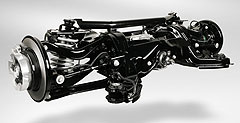Make / Model Search
News - Holden - CommodoreVE Commodore: All the suspense revealed!Freshly baked: The VE is the newest Holden ever. All-new suspension is the headline act in Holden’s VE chassis31 Jul 2006 HOLDEN has released details of its "clean-sheet" chassis underpinning the VE Commodore. Dubbed "Zeta 1", the architecture is destined for widespread usage throughout the General Motors global empire. Key to Zeta 1’s international competitiveness is a completely new front and rear suspension Holden calls ‘Linear Control Suspension’, the fruit of eight years’ development for the company. Banished for good are the bones of the 1978 VB Commodore-derived strut front suspension. In its place is a multi-link MacPherson strut-based system incorporating a direct-acting anti-roll bar, with a forward-mounted steering rack and dual lower links with individual ball joints at the outer end, creating a virtual pivot arrangement. A more isolated ride than before is expected thanks to the implementation of a hydraulically damped bush, while precision handling is the upshot of a stiffness-providing rubber spherical joint in the front suspension’s lateral link. "No more add-on kits from aftermarket" is how Holden now describes the arrangement. A negative scrub radius, short spindle length, high castor and short mechanical trail are further features of this set-up. Camber, castor and toe are fully tuneable. Improvements to steering feel, directional stability and handling are promised, while changes to road camber and crosswinds are now better dealt with. For the rear suspension, Holden studied the set-ups found in the Jaguar S-Type, Cadillac CTS, Lexus LS and BMW E39 5 Series, and then benchmarked the latter when creating its four-link independent rear suspension, since the old 5 Series was deemed closest to the Holden brand’s ride and handling aspirations. Engineered with coil-over shock absorbers and a decoupled anti-roll bar, three lateral ball joints each side of the suspension help deliver high lateral stiffness and good longitudinal compliance. To commandeer Ford terminology, NVH (noise, vibration and harshness) properties are quelled using a rubber isolated suspension frame, while camber and toe are adjustable. For future VE variants requiring flatter rear load floors (read: utility and wagon-based vehicles), the coil-over shocks are mounted to the underside of the rear chassis rails instead of the upper wheel arches, enabling Holden to keep all suspension components below the floor. Holden has devised three suspension settings for VE – Comfort (Omega and Berlina), Sport Handling (a 10mm ride-height drop for SV6, SS, SS V, Calais and Calais V), and an optional Country Pack for Omega, resulting in a 25mm ride-height rise. A holistic approach to the suspension’s effectiveness was undertaken from the beginning, with each of the other chassis components integrated with it so as to have the greatest outcome for all of the VE’s occupants.  Moving the steering rack, with its variable ratio gear and 15 per cent change from centre to lock, forward of the front axle centreline (it is behind in the VZ) greatly reduces NVH issues, as Holden was now free to beef up the engine sump. Moving the steering rack, with its variable ratio gear and 15 per cent change from centre to lock, forward of the front axle centreline (it is behind in the VZ) greatly reduces NVH issues, as Holden was now free to beef up the engine sump.It also increases stiffness yet maintains a desired lateral force toe change for a stabilising effect as the driver turns in. Along with an approximately 10 per cent faster ratio on-centre compared to the old car, the new steering system and layout aim to bring improvements to steering connectivity, feel and precision. Meanwhile, the new engine cradle is significantly stiffer and stronger, aids crash protection in the process, helps to quell NVH paths and improves the VE’s dynamic abilities. German company ZF devised a lighter differential with a gear set featuring a larger crown wheel (8.3 inches). For NVH purposes it is now double-isolated from the rear suspension frame. A multi-plate clutch system for the limited-slip differential units ousts the old cone clutch mechanisms that hampered previous Commodores, allowing for more progressive breakaway attitudes. The brakes are bigger, quieter (an apply sensor replaces two switches), offer a stiffer pedal feel, and have a stopping distance advantage over VZ of five per cent. Both V6s receive 16-inch brakes (298mm x 30mm vented front rotors and 302mm x 22mm vented rear rotors), clamped by twin-piston and single-piston aluminium callipers front and back respectively. Meanwhile, V8s gain a 17-inch set-up, reading 321mm x 30mm front and 324mm x 22mm rear, with the same hardware as the V6s. Even the Saab 9-3-inspired integrated-park brake has been overhauled. Now lighter, it also easily adapts to left-hand drive. As a result of the new chassis, Holden has achieved an almost 50/50 front/rear weight balance, fluctuating one per cent either way from unladen to three passengers onboard. Target weight HOLDEN claims it had a target mass of around 1660/1670kg for the base Omega model. The end result is 1690kg, versus the equivalent VZ Commodore Executive’s 1570kg. The VE Calais V series V8 weighs 1825kg. "That was set early on, but pretty early on we knew we were not going to quite get there ... we were comfortable to move slightly away from that target," Holden’s director – integration and experimental Ian Butler said. |
Click to shareHolden articlesCommodore pricing
Motor industry news |









Facebook Twitter Instagram